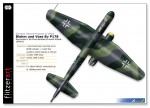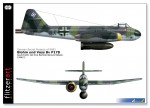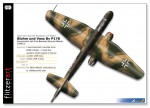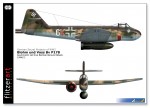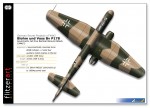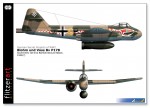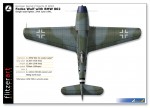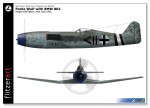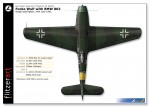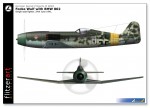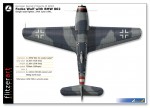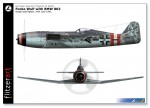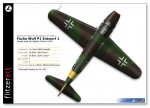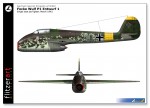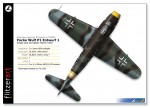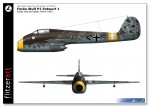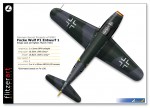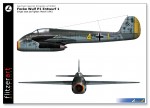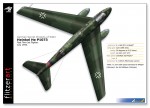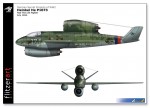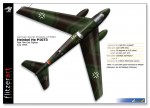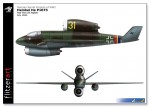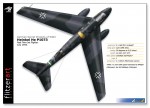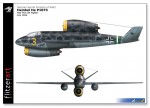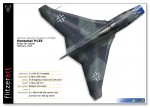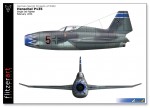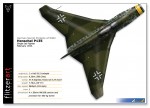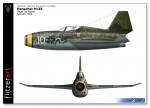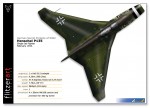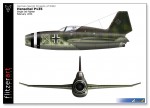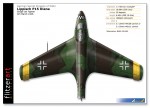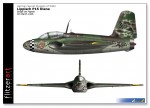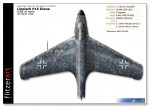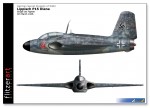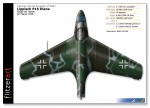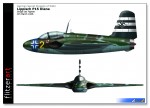German Secret Projects of WW2 Volume 8
6
Comments
Section 2 - Miscellaneous Aircraft Projects
Blohm and Voss P178This asymmetric designed dive-bomber had one Jumo 004B turbojet located under the wing to the starboard side of the fuselage. The pilot sat in a cockpit in the forward fuselage, with a large fuel tank located to the rear of the cockpit. Beneath the fuel tank there was a deep recession in which a SC 500 bomb could be carried within the fuselage, or a SC 1000 bomb, which would protrude slightly out of the fuselage. Two solid-fuel auxiliary rocket engines extended from the rear, and may have possibly been used for take-off or for climbing after a dive-bombing attack. Two MG 151 15mm machine guns were located in the nose.
Focke Wulf with BMW 802
In August 1941, Dipl-Ing Mittelhuber produced a design study on the performance of single-seat fighters with power plants still under development. This was based on the Fw 190 fighter, which was just entering service at that time. The new design researched was based on the Fw 190 airframe, but with the BMW 802 18-cylinder, twin-row radial engine with a three-speed, single stage supercharger. This engine had a 2600 HP take-off rating, and could deliver 1600 HP at an altitude of 12000 m (39000'). The engine was to be housed in a BMW designed low drag cowling driving a 3.8 m (12' 6") variable pitch propeller.
An alternate engine arrangement, which was considered but not included in this study, was the BMW P.8011 engine. This power plant had a 2800-2900 HP take off rating. It was basically a BMW 802 with two exhaust gas turbines enclosed in an aerodynamic cowling, and it drove two contra rotating propellers. A bomb load of 500 kg (1102 lbs) or two 300-liter (66 gallon) drop tanks could be carried, or an optional 50 kg (110 lbs) bomb under each wing. No armament was provided for at this design stage. Although this project was not realised, Focke-Wulf went on to develop their successful Ta 152 high altitude fighters.
Note: The American Chance Vought F4U Corsair was a very similar aircraft in many respects such as weights, dimensions, type of power plant and power and is a perfect example of how close to ‘in-service’ estimates of the German design were.
At 26,000 feet the Corsair delivered a top speed of 443mph (714kph) while the estimates for the Focke wulf at the same altitude was 450mph (725kph).
Focke Wulf P1
After researching a possible jet conversion of the existing Fw190 the company produced their first real jet concept. It still relied heavily on the Fw190 for parts such as the wings and undercarriage; it moved the cockpit forward and placed the jet engine directly underneath, resulting in a long slender fuselage boom leading to the conventional tail. The undercarriage arrangement was to retain the tail wheel undercarriage. Although the concept had merit the RLM considered the exhaust to be too risky due to this type of undercarriage.
The Russian Yak 15 and 17 bare a remarkable similarity to the Fw P1 and use a Soviet version of the Jumo 004. The first version of the Yak 15 also had a tail wheel type of undercarriage, but by the time the Yak 17 had been introduced a tricycle type had been adopted.
Henschel P135
Henschel submitted this design (which they had previously independently designed) for the 1944 Luftwaffe high-command specification for a single-seat fighter to be powered by a HeS 011 turbojet. This aircraft design was intended to achieve better high-speed performance through the reduction of air resistance. The aircraft was tailless and featured an innovative wing design, still found on aircraft today, a compound swept wing with the angle of sweep sharply reduced near the wingtip. This has the effect of reducing turbulence by spreading out the compression effect along the length of the wing as Mach speed was approached, enabling the aircraft to carry more weight at higher speed. The fuselage was thus thicker in both height and width, as well as heavier, which made the aircraft more structurally sound without adversely affecting performance. Four MK 108 30mm cannon were the projected armament.
Heinkel P1073
This was Heinkel's original design of the P.1073, which was later redesigned for submission in the Volksjager competition, becoming the He 162 Salamander. This earlier version featured a mid-mounted sweptback wing with a V tail. The two HeS 011 jet engines or two BMW 003 turbojets were located one on top and one underneath the fuselage in order to keep the wings unencumbered. Two MK 108 30mm cannon were the projected armament.
The performance estimates showed an appreciable improvement over the Me262, but the nose wheel position ahead of the lower engine intake may have caused problems of ingestion of debris on take-off.
Lippisch P15 Diana
The Lippisch P.15 was a proposed development of the Me 163 "Komet". The nose of the aircraft was taken from the He 162 and the main landing gear from the Bf 109. The wings came from the Me 163, with their span being increased by the addition of air intakes in the leading edge wing roots. A single He S 011A turbojet supplied the power. Armament would have consisted of two Mk 108 30mm cannon in the forward fuselage sides and two MG 151/20 20mm cannon in the wing.
Comments
Many thanks to Rowan.
I missed 2 whole descriptive parts of the text. Thanks
Peter
APR 11, 2011 - 02:05 AM
Hi Peter
No worries, but I'm relieved I wasn't going nuts when I thought something was missing! Many thanks for submitting such a great article.
All the best
Rowan
APR 11, 2011 - 09:17 AM
Great work once again from you, Peter. Very inspirational.
Thanks for sharing.
APR 11, 2011 - 12:40 PM
Many thanks Jesper.
Glad you like them.
A few bombers mixed in next time.
Brilliant job by Merlin as per usual.
Peter
APR 13, 2011 - 02:49 AM
Copyright ©2021 by Peter Allen. Images also by copyright holder unless otherwise noted. The views and opinions expressed herein are solely the views and opinions of the authors and/or contributors to this Web site and do not necessarily represent the views and/or opinions of AeroScale, KitMaker Network, or Silver Star Enterrpises. Images also by copyright holder unless otherwise noted. Opinions expressed are those of the author(s) and not necessarily those of AeroScale. All rights reserved. Originally published on: 2011-04-10 00:00:00. Unique Reads: 29303




